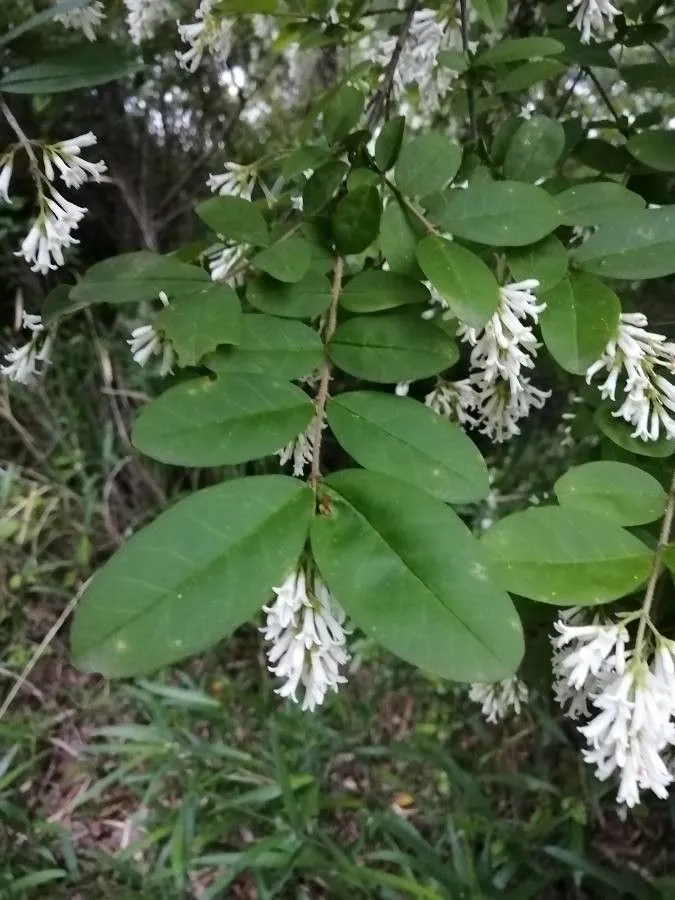
Author: Siebold & Zucc.
Bibliography: Abh. Math.-Phys. Cl. Königl. Bayer. Akad. Wiss. 4(3): 168 (1846)
Year: 1846
Status: accepted
Rank: species
Genus: Ligustrum
Vegetable: False
Observations: E. China to Japan
Border privet, scientifically known as Ligustrum obtusifolium, belongs to the family Oleaceae. This hardy, deciduous shrub is prized in landscaping for its adaptability and dense growth habit, making it an excellent choice for hedges and borders. Originally catalogued by Siebold and Zuccarini in 1846, the species can trace its native roots to regions extending from Eastern China to Japan.
The border privet is celebrated for its resilient nature and capacity to thrive in a variety of soil conditions, provided they are well-drained. It flourishes under full sunlight to partial shade, demonstrating a notable tolerance for urban environments and pollution, which adds to its popularity in city gardens and public spaces. Reaching up to 6-12 feet in height, it boasts a dense network of branches covered in dark green, oval leaves that turn purple in the fall, providing seasonal interest.
In spring to early summer, the border privet produces small, fragrant, white to cream-colored flowers in clusters. These blossoms are not only visually appealing but also attract pollinators such as bees and butterflies. Following the flowering period, the shrub develops small, black berries that persist into winter, providing a food source for birds and contributing to its ornamental appeal.
Notably disease-resistant and low-maintenance, the border privet requires minimal care once established. It benefits from occasional pruning to maintain the desired shape and density, particularly when used as a formal hedge. This versatility and ease of care make it a favorite among landscape architects and gardening enthusiasts alike.
Whether utilized for privacy screens, windbreaks, or simply as an attractive ornamental plant, Ligustrum obtusifolium stands out as a robust and aesthetically pleasing addition to various gardening projects.
Eng: border privet, border-privet
Dan: butbladet liguster
Swe: japansk liguster
En: Border privet, Border-privet
Da: Butbladet liguster
Ko: Gomdzongalnamu, Jwittongnamu
Sv: Japansk liguster
© copyright of the Board of Trustees of the Royal Botanic Gardens, Kew.
© copyright of the Board of Trustees of the Royal Botanic Gardens, Kew.
© copyright of the Board of Trustees of the Royal Botanic Gardens, Kew.
Taken Jun 20, 2010 by Martin Bishop (cc-by-sa)
Taken Jul 15, 2020 by Eddie Veenstra (cc-by-sa)
Taken Jun 8, 2022 by Jeanine Zimmerman (cc-by-sa)
Taken Apr 16, 2022 by Andrzej Konstantynowicz (cc-by-sa)
Taken May 31, 2021 by Jack Pommer (cc-by-sa)
Taken Oct 8, 2022 by Miro (cc-by-sa)
Taken May 31, 2021 by Jack Pommer (cc-by-sa)
Taken Jun 8, 2022 by Jeanine Zimmerman (cc-by-sa)
Taken May 20, 2020 by Hissanova Nakamrah (cc-by-sa)
Growth habit: Shrub
Family: Myrtaceae Author: (F.Muell.) K.D.Hill & L.A.S.Johnson Bibliography: Telopea 6: 402 (1995) Year: 1995 Status:…
Family: Rubiaceae Author: Pierre ex A.Froehner Bibliography: Notizbl. Bot. Gart. Berlin-Dahlem 1: 237 (1897) Year:…
Family: Sapindaceae Author: Koidz. Bibliography: J. Coll. Sci. Imp. Univ. Tokyo 32(1): 38 (1911) Year:…
Family: Asteraceae Author: A.Gray Bibliography: Pacif. Railr. Rep.: 107 (1857) Year: 1857 Status: accepted Rank:…
Family: Fabaceae Author: Medik. Bibliography: Vorles. Churpfälz. Phys.-Ökon. Ges. 2: 398 (1787) Year: 1787 Status:…
Family: Aspleniaceae Author: (Cav.) Alston Bibliography: Bull. Misc. Inform. Kew 1932: 309 (1932) Year: 1932…